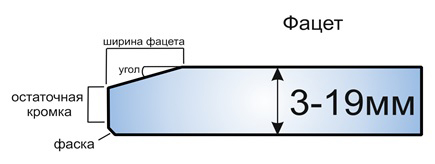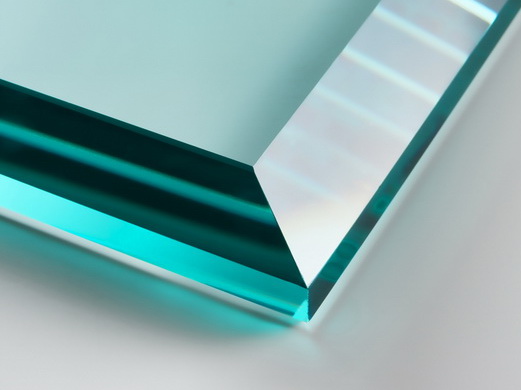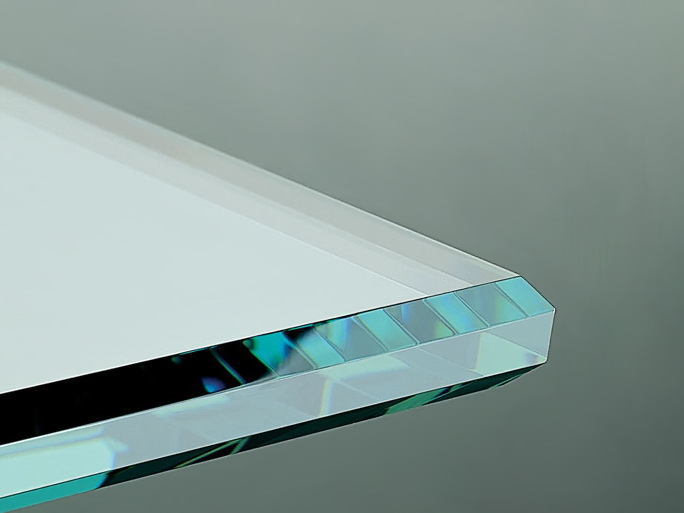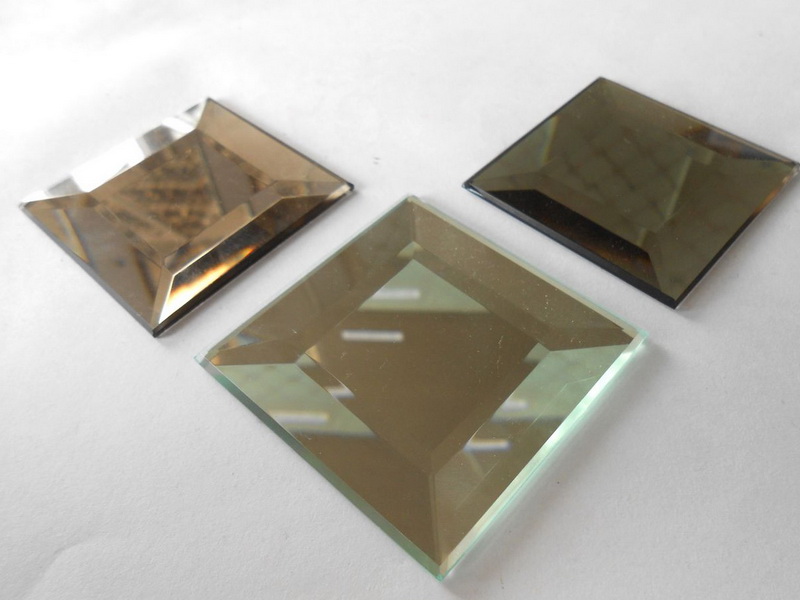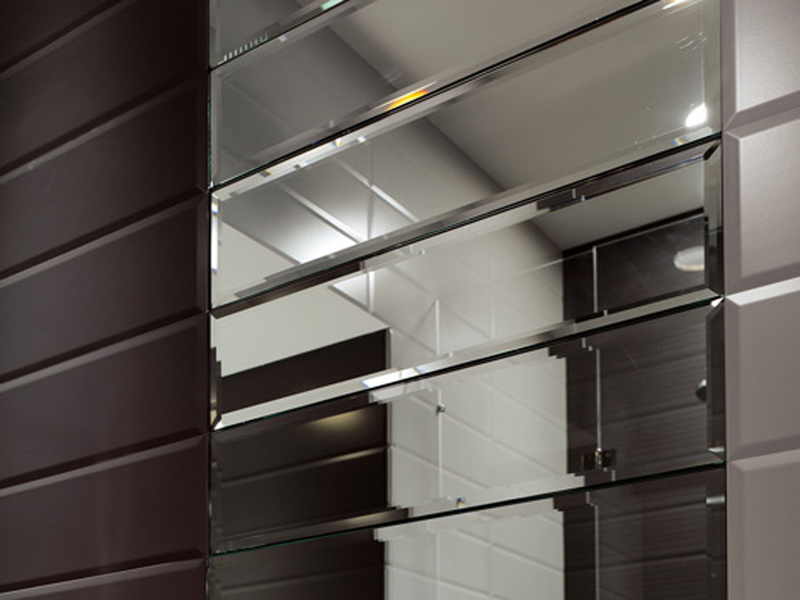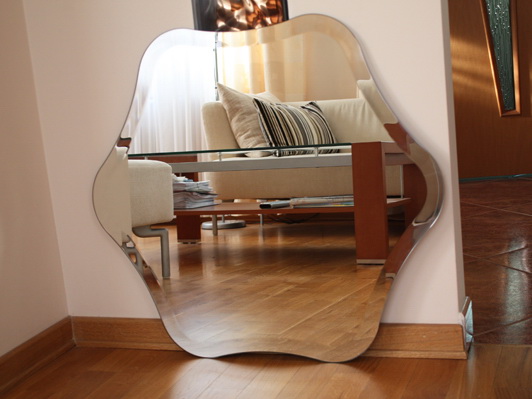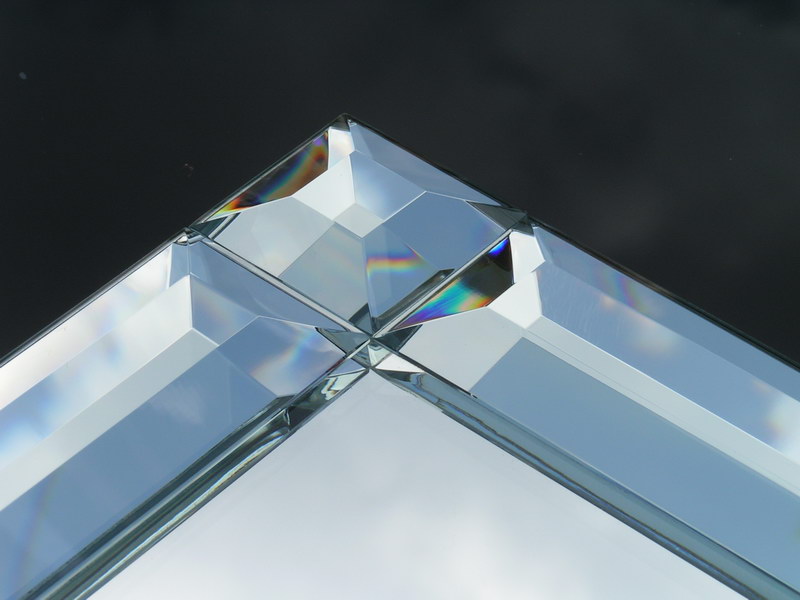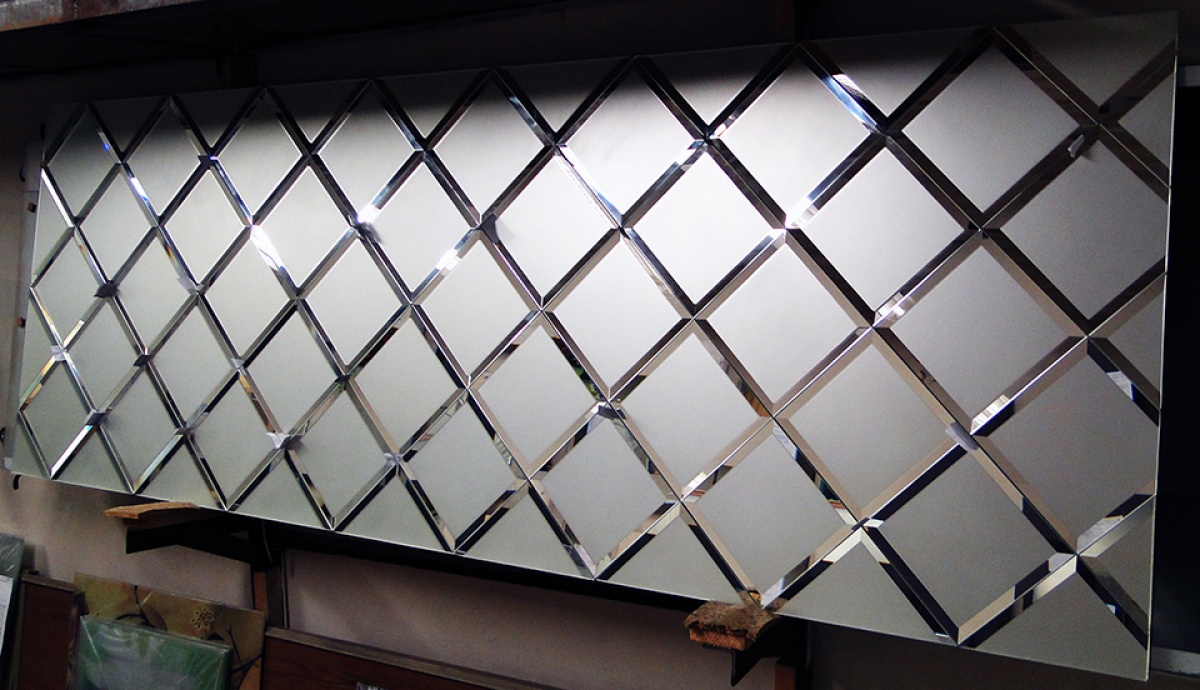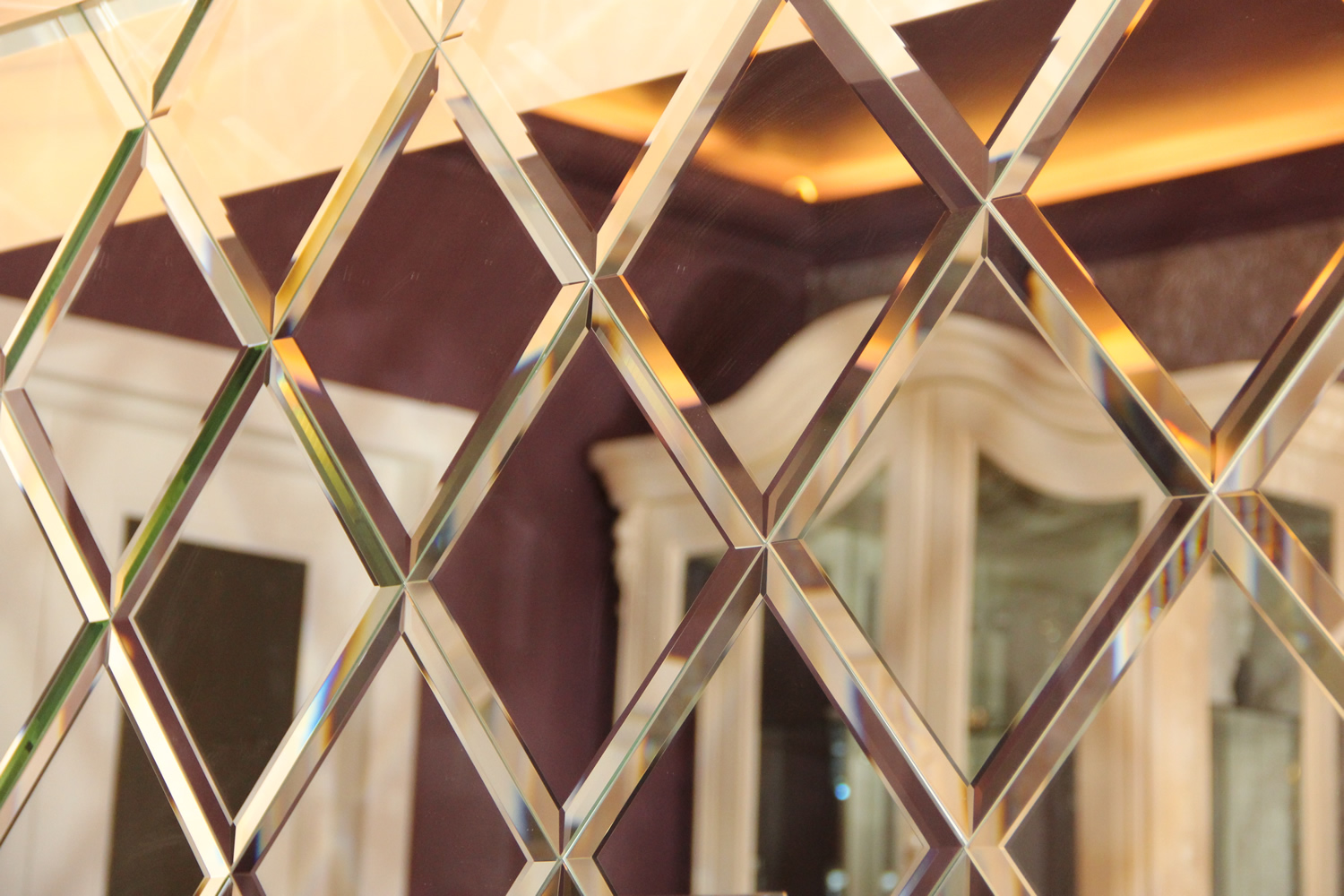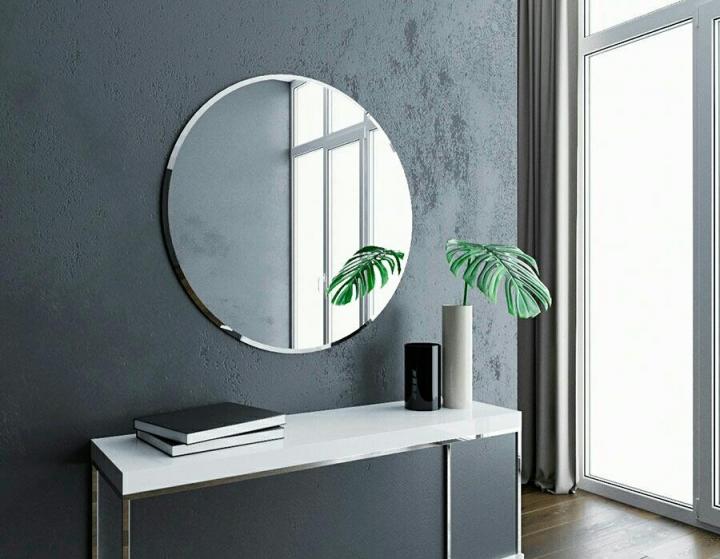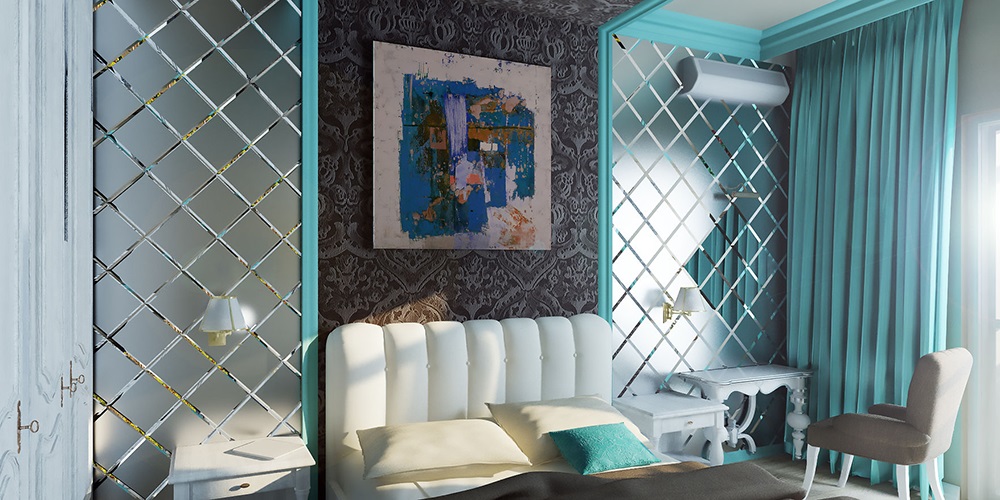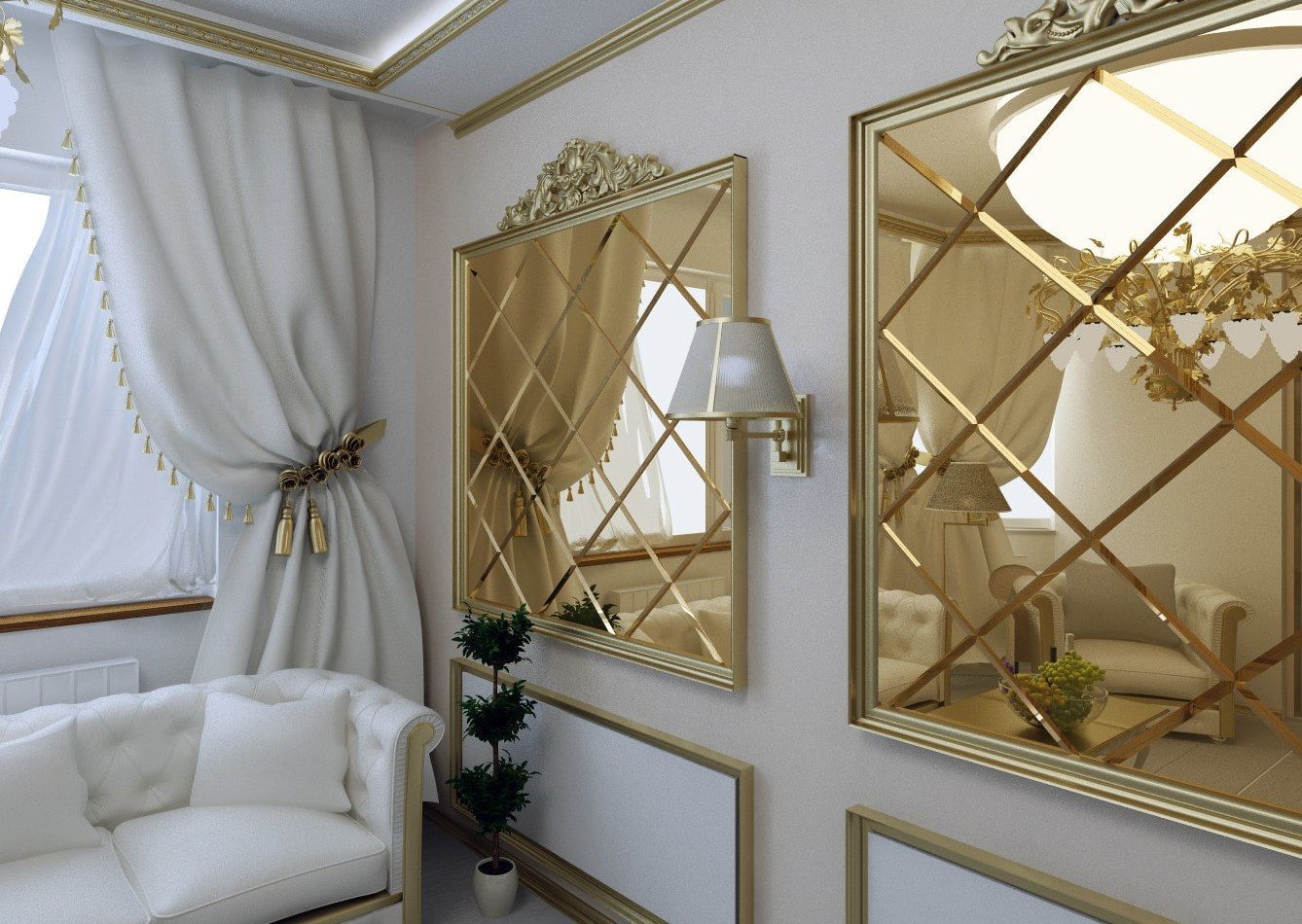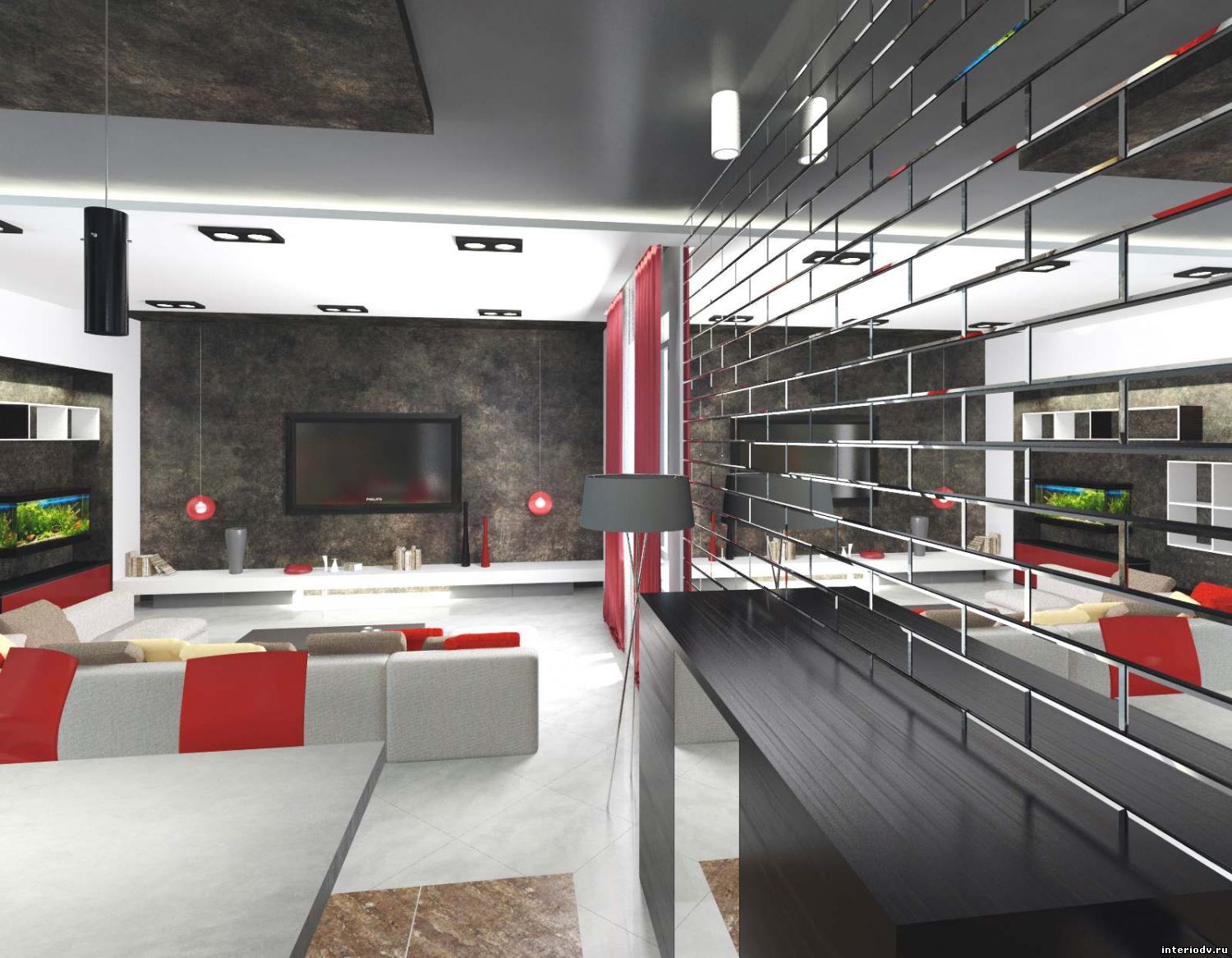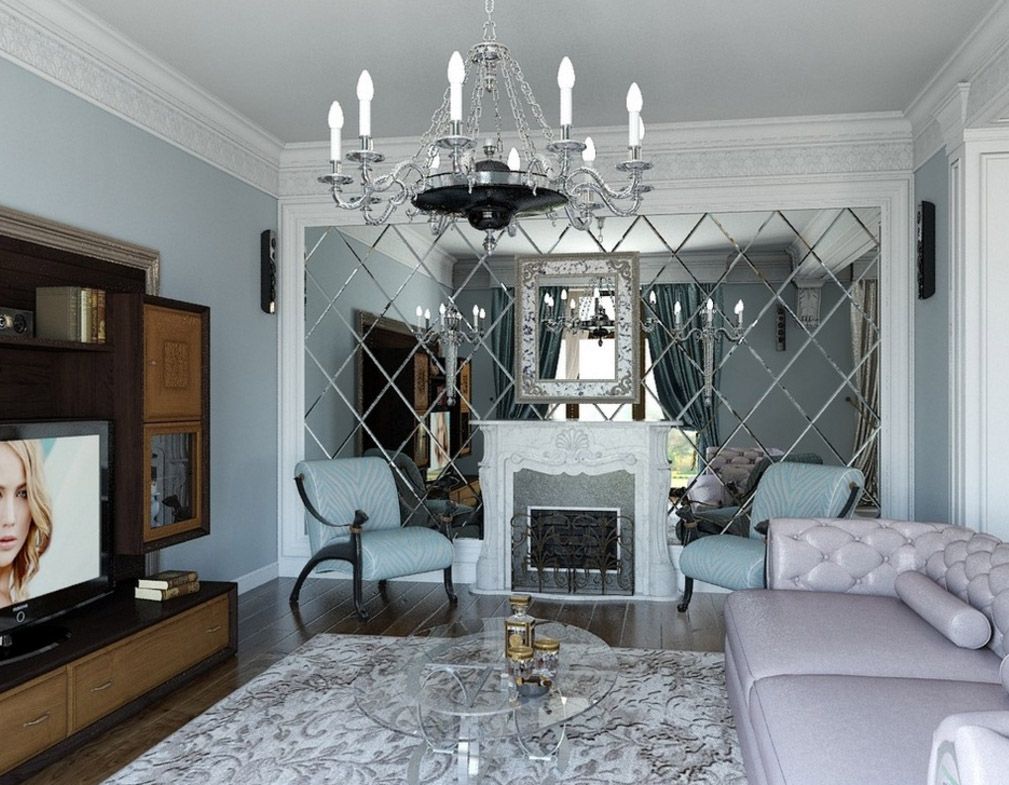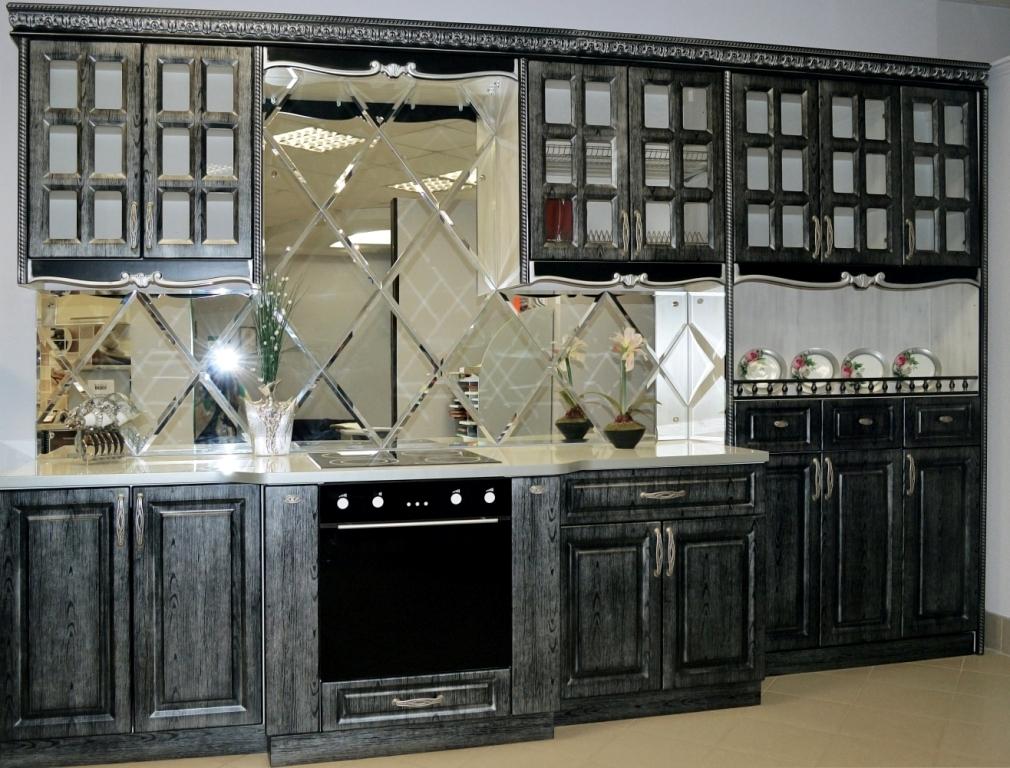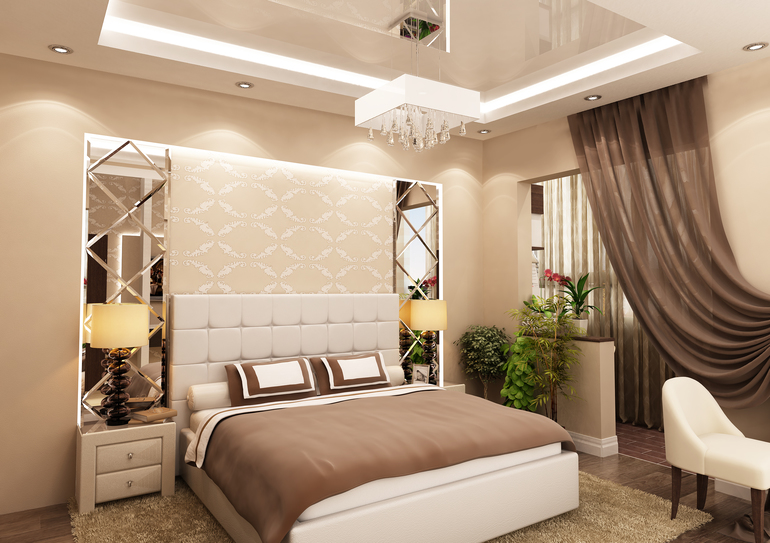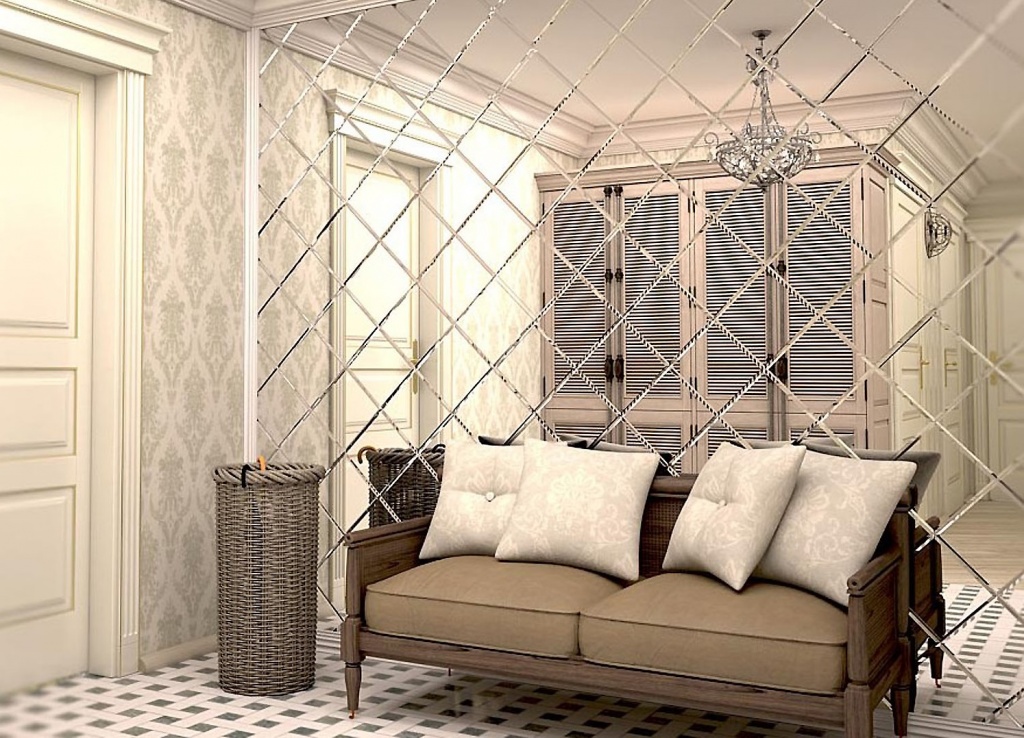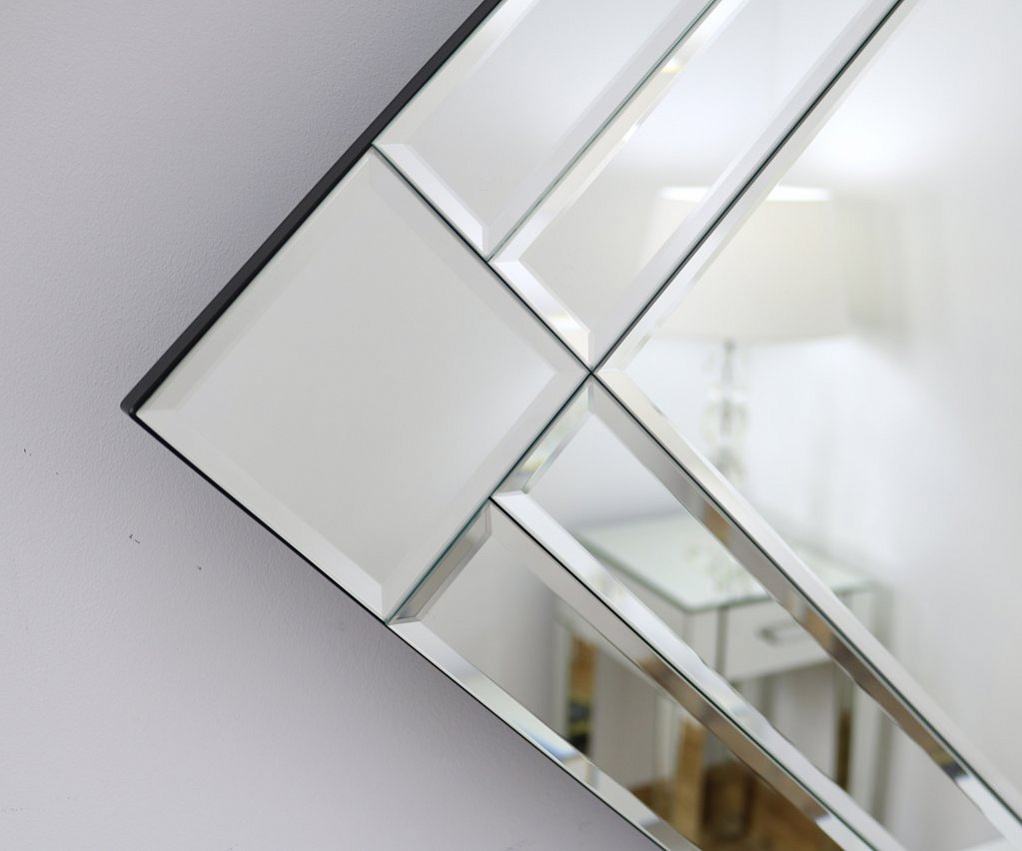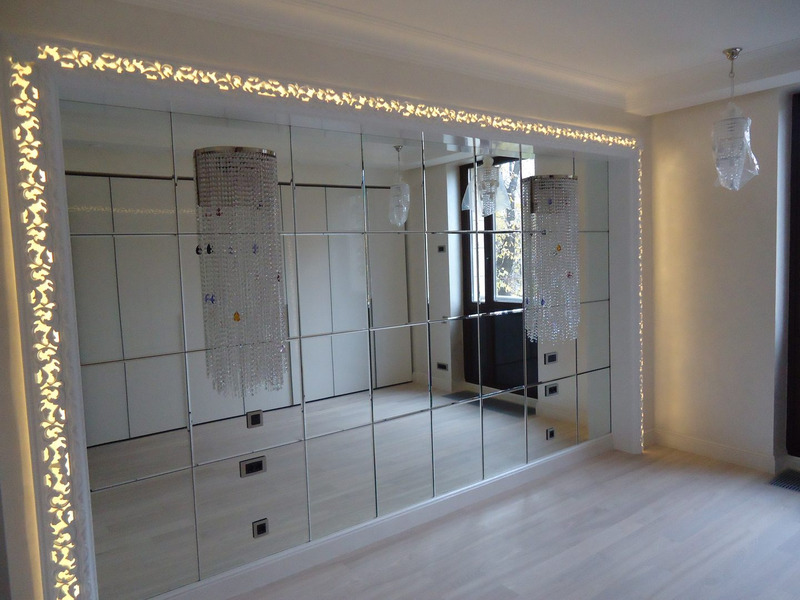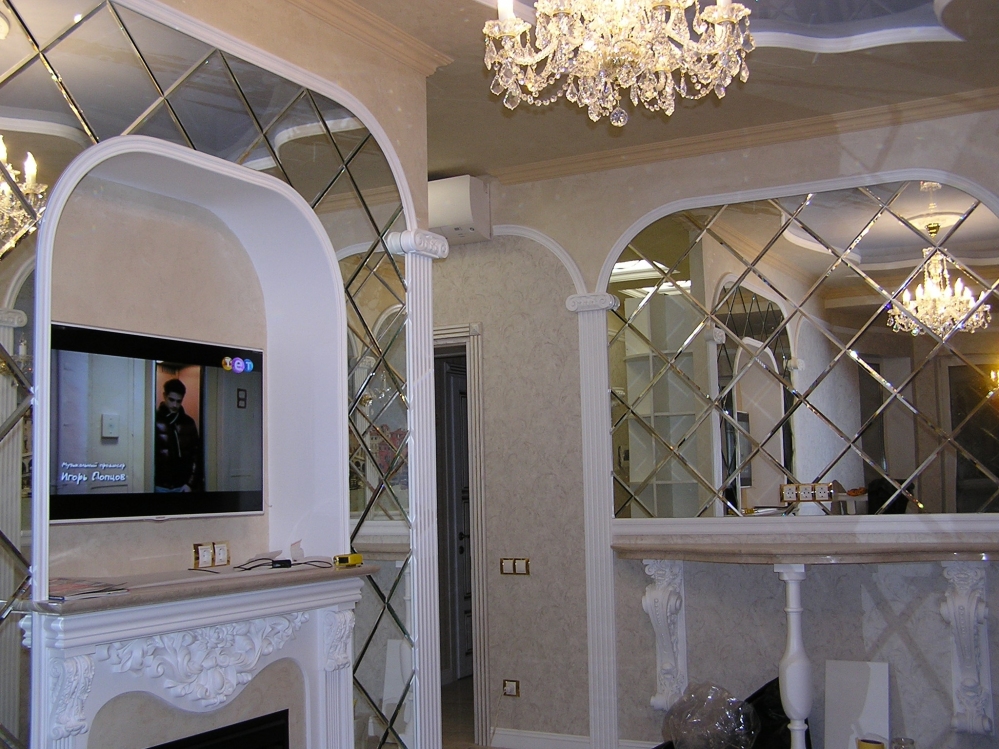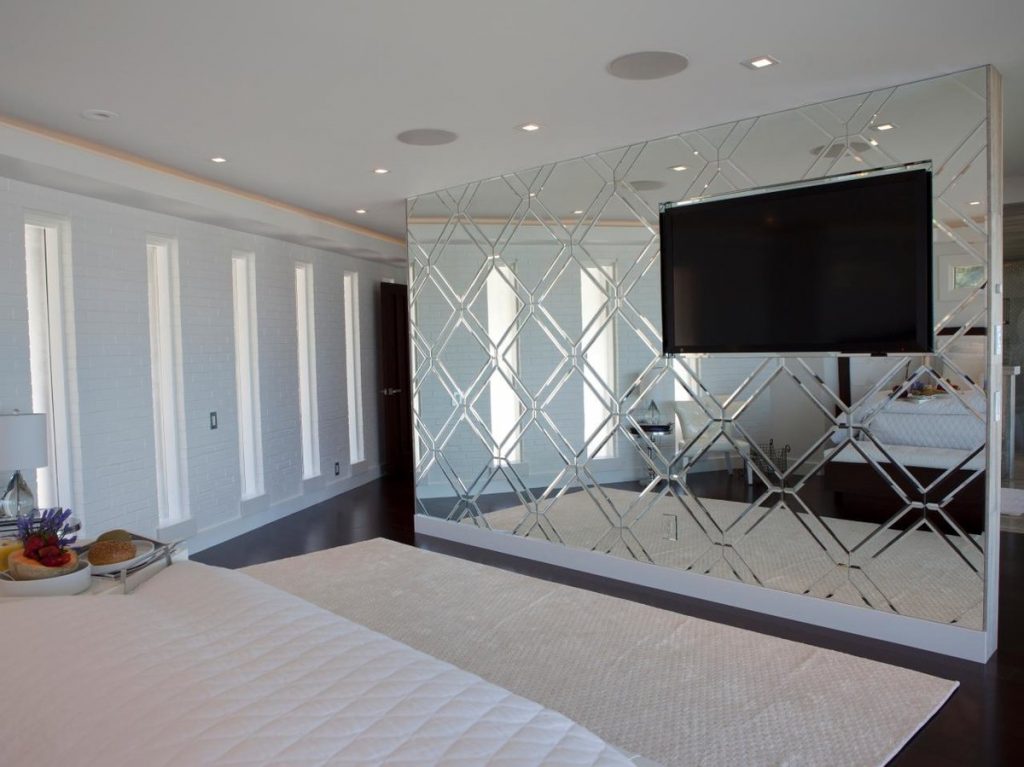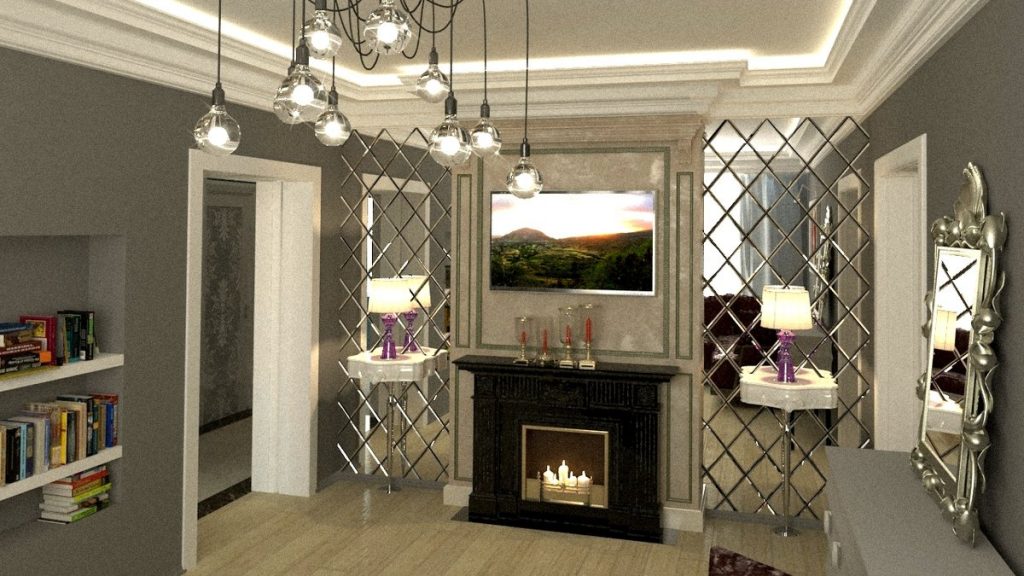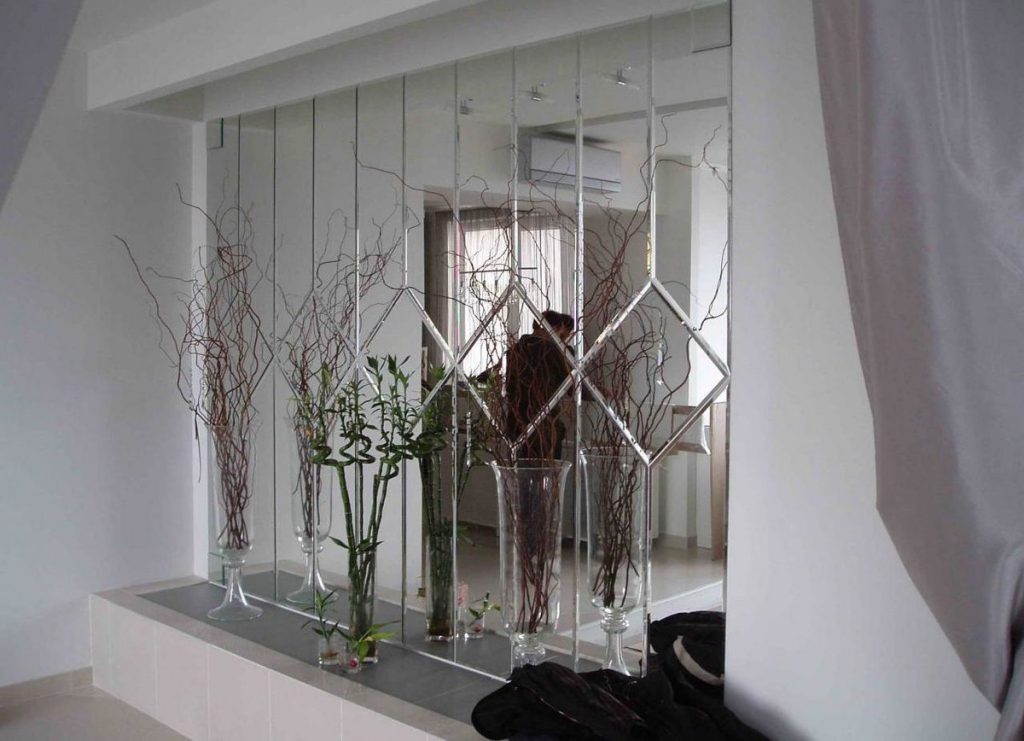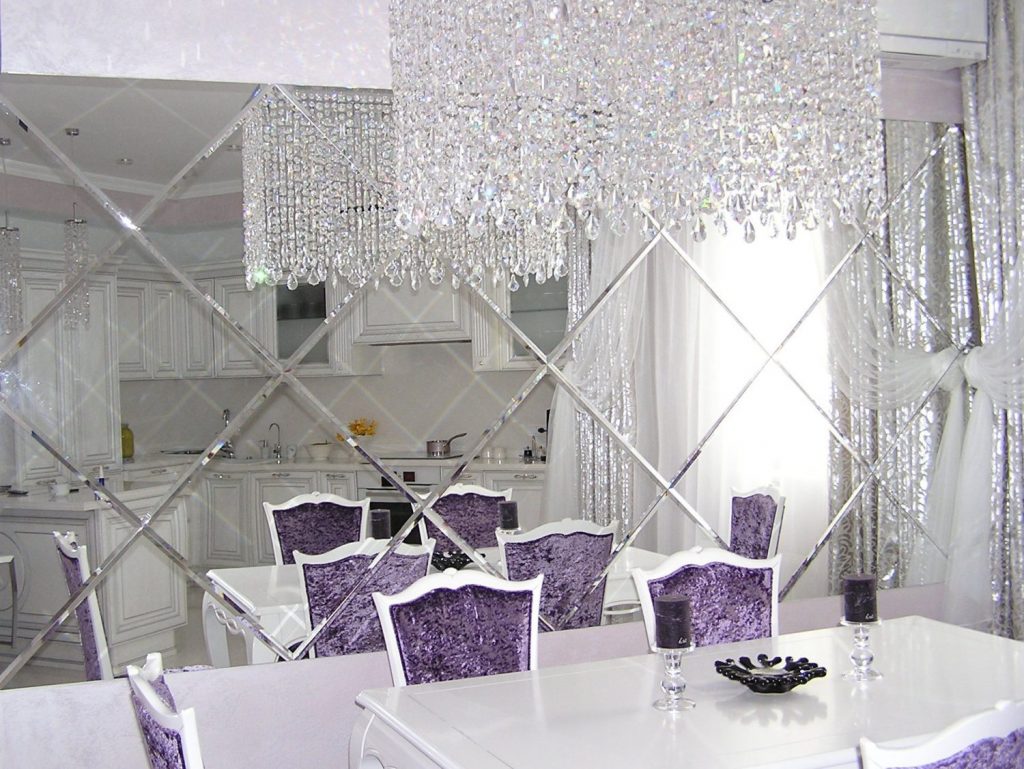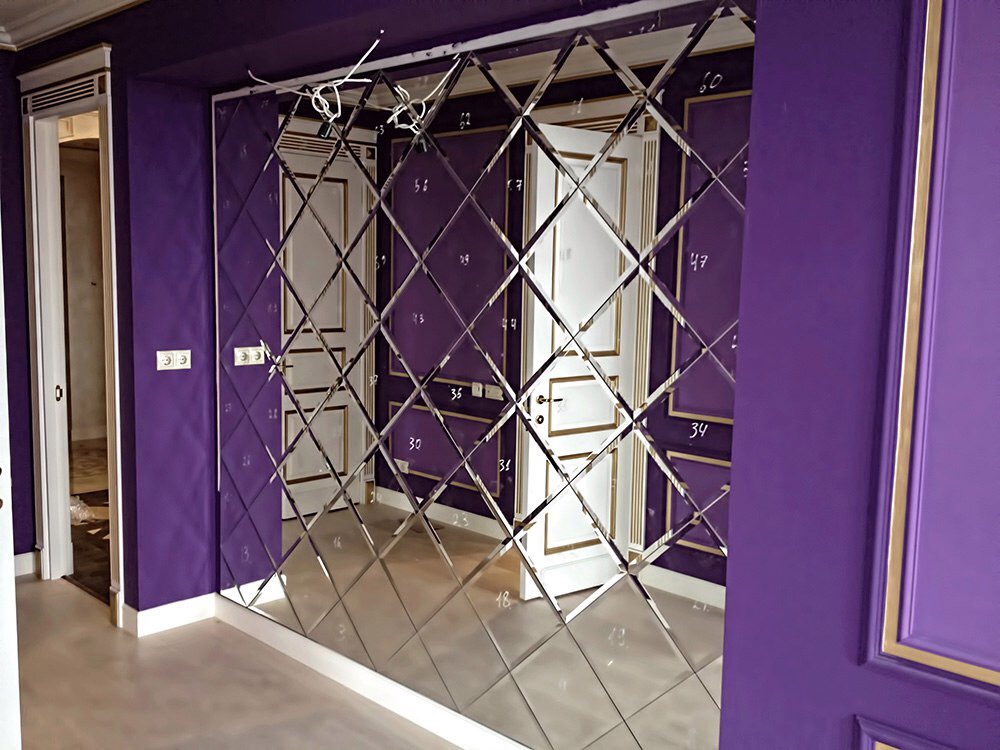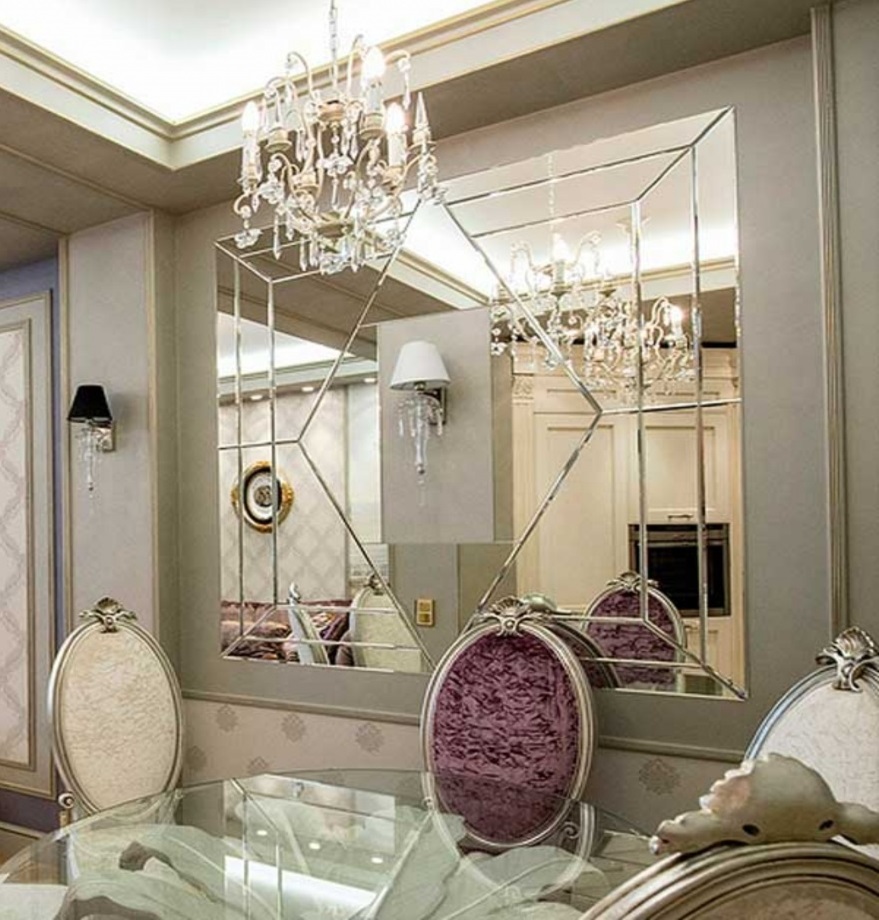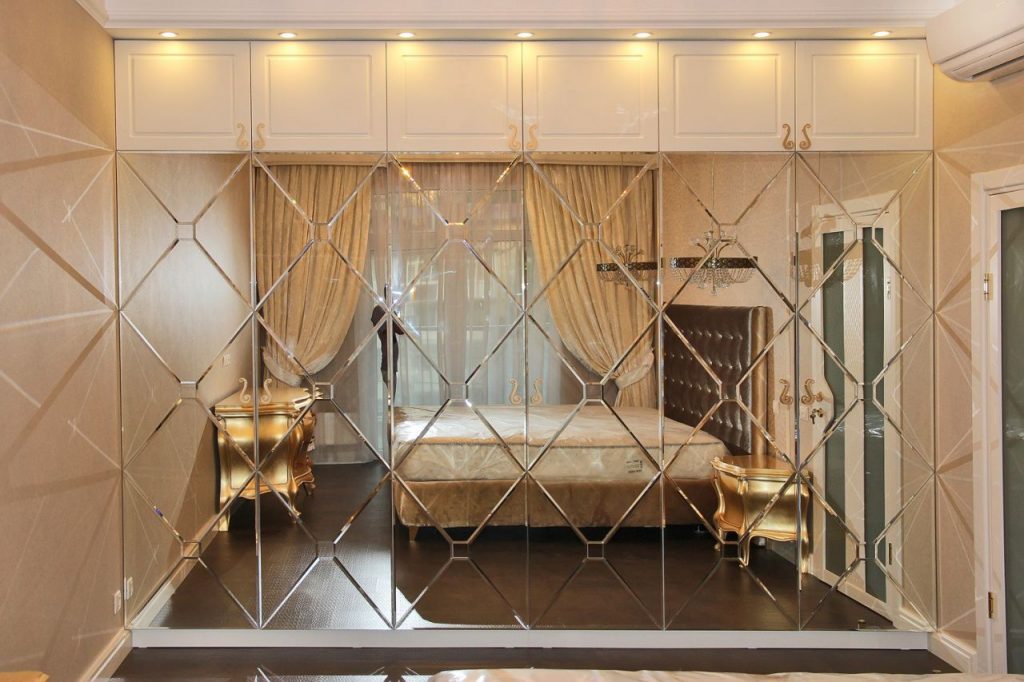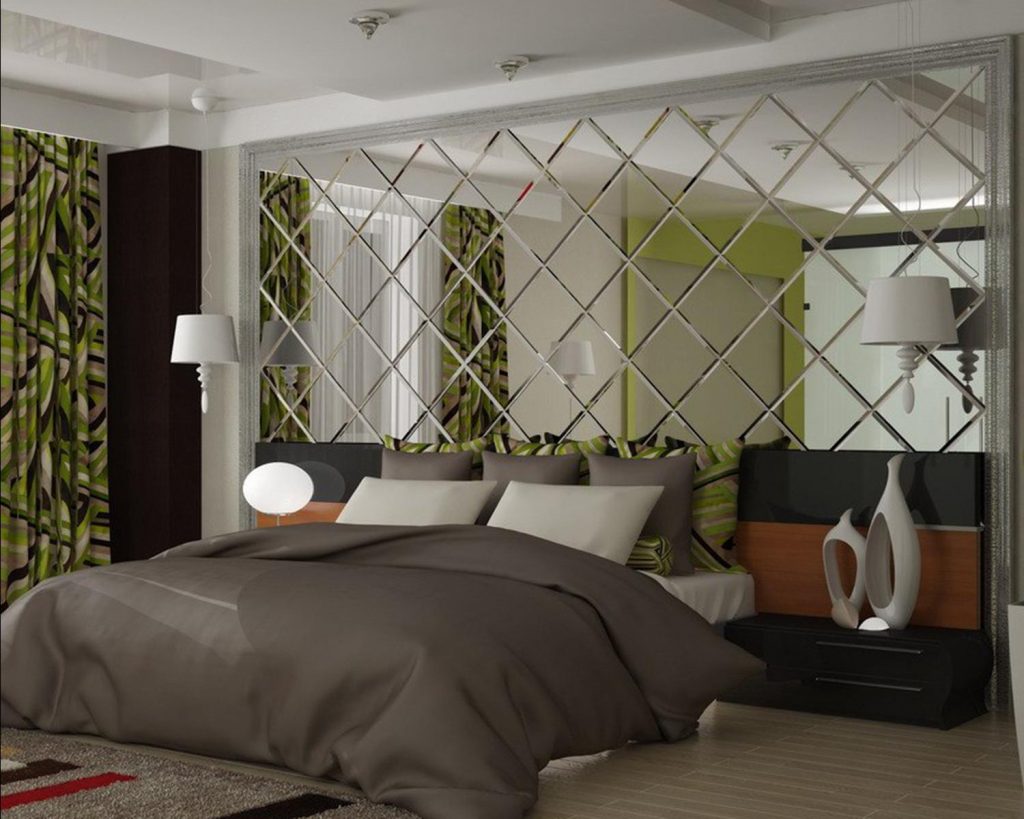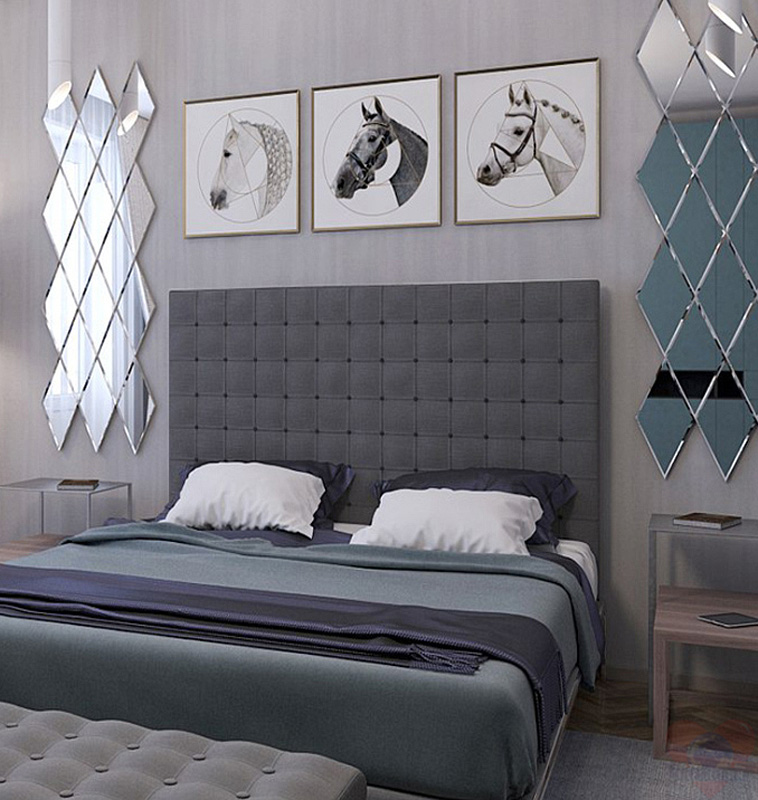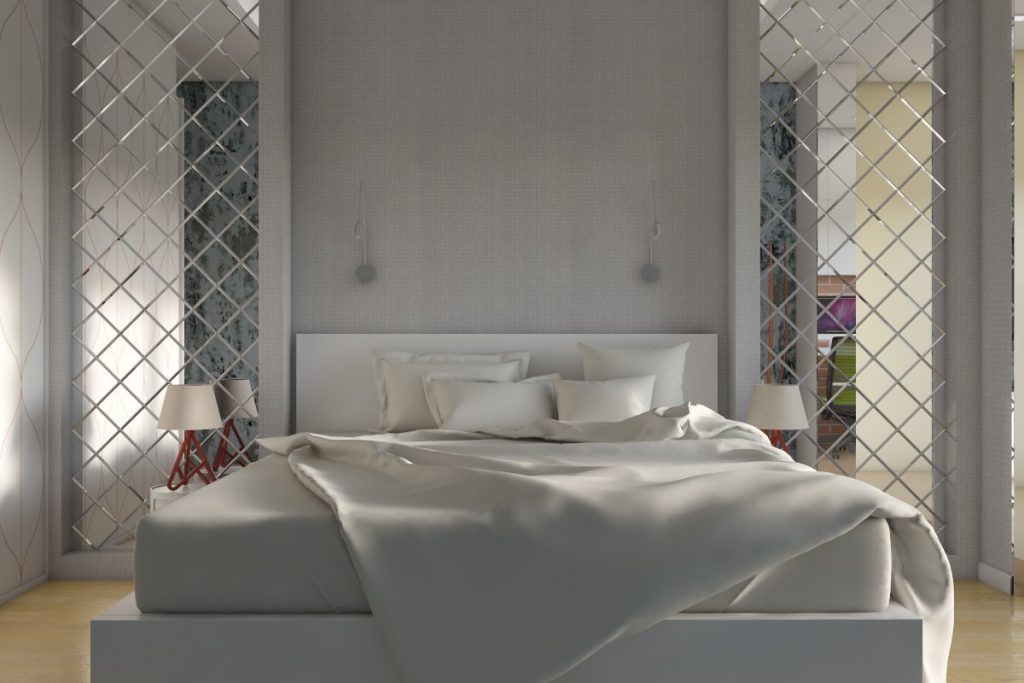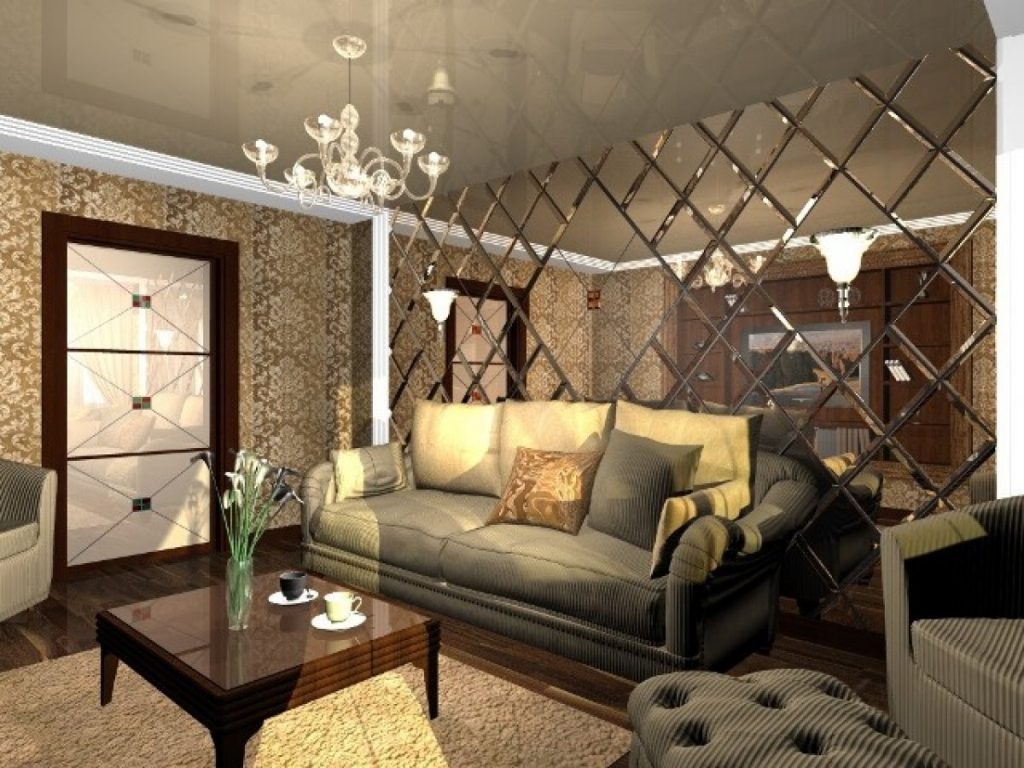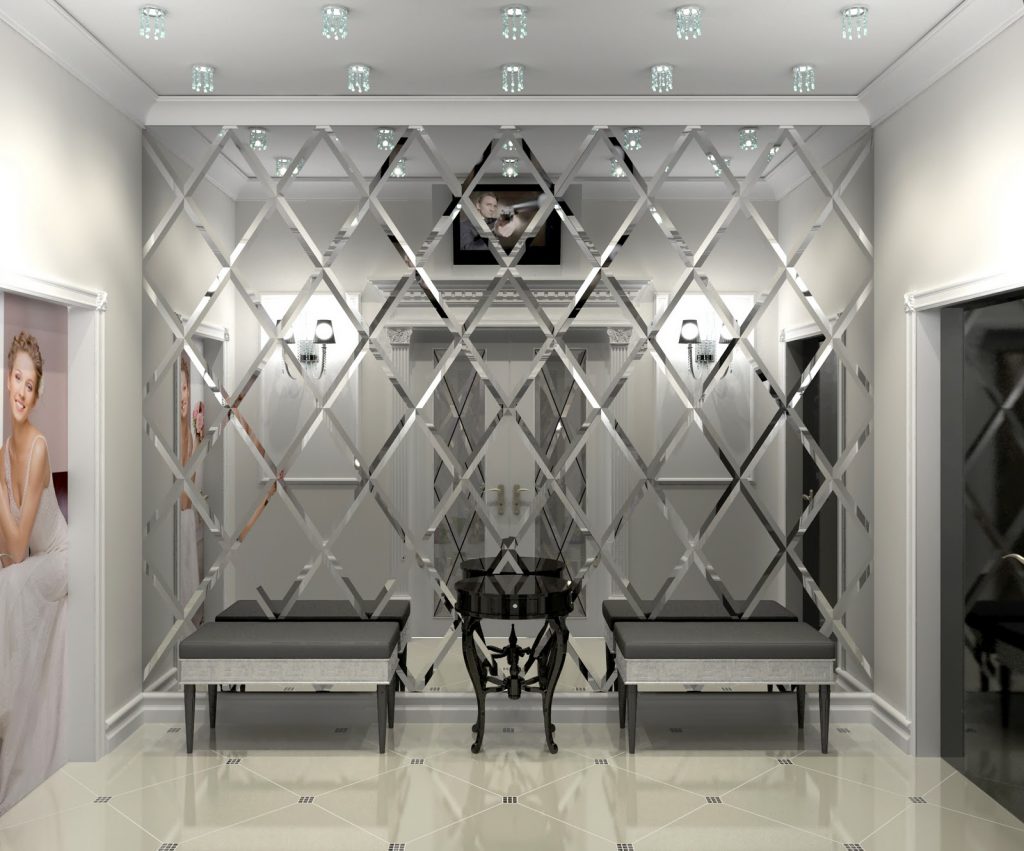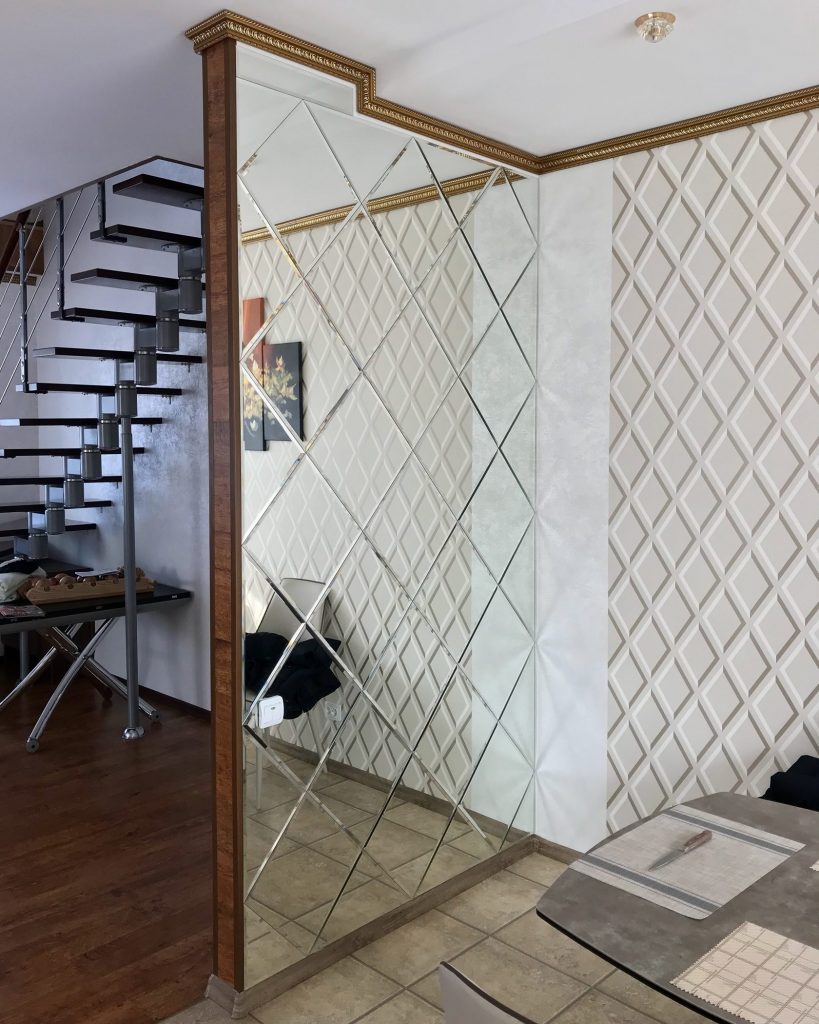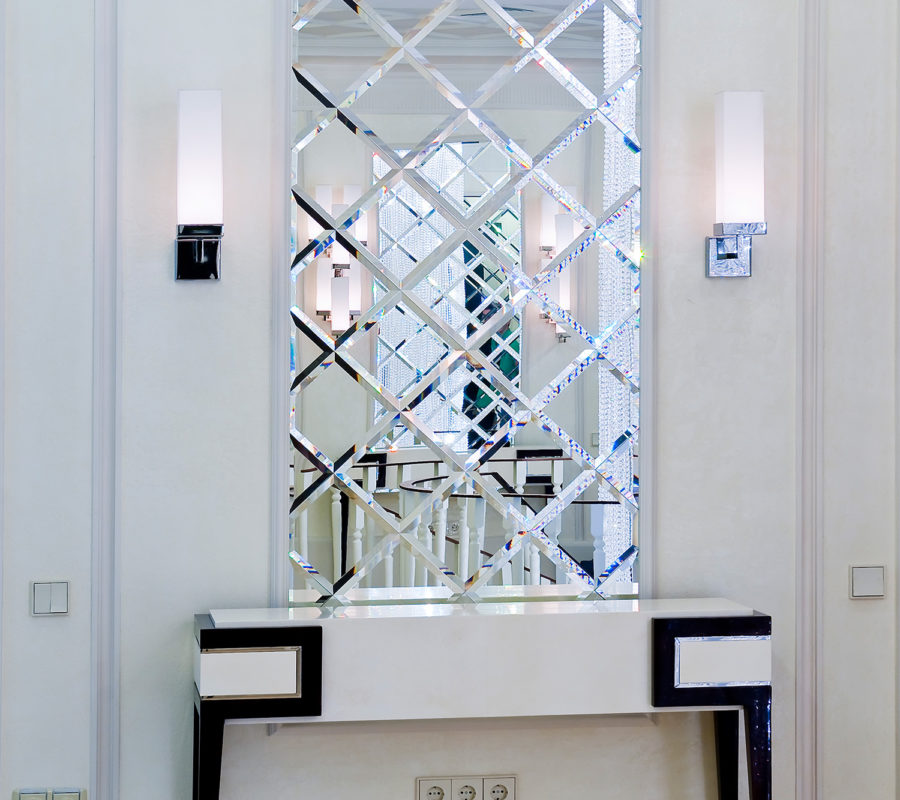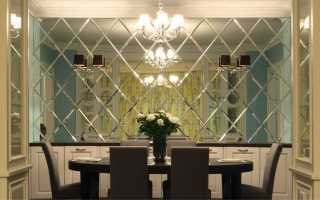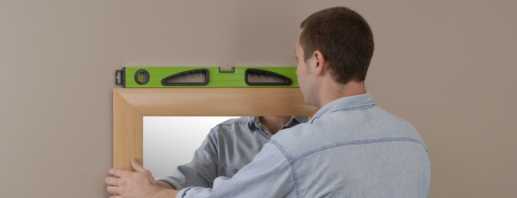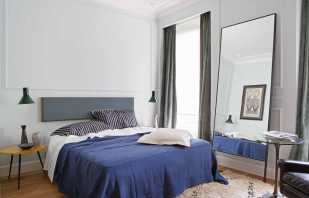What is a facet on a mirror, forms and methods of processing

Reflective surfaces on ceilings, walls, furniture facades are actively used to create an original interior in apartments, houses, offices. One of the most unusual design decisions is the facet on the mirror, what it is - not everyone knows. Meanwhile, such products qualitatively transform any environment, give it personality and presentability.
Content
What is a
The term facet originated in France, translated as the external facet, chamfer. It was there that they first began to use the technology of decorative processing of the edges of mirrors and glasses. Framing gives the surface a finished look, is made at an angle of up to 45º, due to which the light is refracted, a special shine is emitted, giving the product nobleness and sophistication.
Today, the decoration of the mirror canvas is carried out on special equipment. This allows you to create different types of facets. The most widespread is the one-sided version, which is a side face, beveled on only one side. Two-sided is more interesting, along the wide edge they make another edging - narrower. Reception gives the frame brightness, expressiveness, a unique radiance appears due to the double refraction of light.
The secret to the facet's popularity lies in its incredible visual effects. The beveled edges refract the rays of the sun, like a prism, dividing the light into multi-colored components. Many people, having learned what facet is, dream of decorating their own home or office with a similar element.
Touching the original frame, it is almost impossible to cut yourself. In the production process, sharp edges are smoothed and carefully polished, so the risk of injury is reduced to zero.
Processing methods
There are several types of facets, which allows you to choose the most optimal option for different products. The straight line is made on standard square or rhombus-shaped glasses without rounded edges. It is used for decorating coffee tables, partitions, doors, double-glazed windows.
The curvilinear method is suitable for processing non-standard forms: ovals, waves, arches and other products with a figured contour. Double facet is used to enhance the visual effect. The cut in this case consists of two bands: narrow and wide, so the refraction of light will be stronger. The finished frame resembles a precious decoration, looks luxurious.
Triple means multiple chamfering. Each subsequent bevel is narrower than the previous one. This gives the canvas a decorative effect similar to diamond cutting.The more faces, the more beautiful the product.
To create a frame, frosted and polished processing is used, which gives the glass a special charm. Unusually looks matte mirror with a facet made of transparent stripes. On a canvas with a thickness of less than 5 mm, the edge is ground at the same time as the decoration. If indicators exceed 6 mm, edges are processed separately.
Term«facet» often confused with «falsetto». These are completely different concepts. The latter is a high male or female voice.
Types of forms and purpose of mirrors with facet
Modern manufacturers create a variety of products that are used for decoration, play a decorative or functional role. There are a variety of forms: from traditional in the form of a rectangle to non-standard. A wide assortment allows you to choose the best option in accordance with the interior, taste, purpose of the models.
Wall
A common variety, any processing methods can be used to create the cut. The standard shape is square or rectangular, but there are round, oval, hexagonal. In shaded rooms, it is recommended to hang products not opposite the window, but slightly at an angle. This leads to improved natural light in the room.
Canvases without a frame, inserted into niches, visually expand the space. The classic dimensions are 60 x 90, but you can make a custom mirror that covers the entire wall.
Frames are able to completely change the appearance of the paintings. Framing gives a sense of completeness, helps to harmoniously fit the product into the chosen interior style. Baguettes are created from:
- plastic;
- wood;
- metal.
Modern technologies allow you to color and decorate inexpensive materials so that they look no worse than elite ones. Thin frames are relevant for large mirrors. Aluminum baguettes harmonize with the hi-tech style. Products create the illusion of fullness due to reflected objects.
Panel
It is used to emphasize certain interior items: a beautiful painting, an antique vase, an elegant box. The most popular mirror is facets with rhombuses, which can visually increase the space. The decoration of the canvas is the processing of the edge, giving the effect of stained glass.
The mirror edge is covered with faceted rhombuses of the same material, then framed with baguettes made under stucco molding or wood. A similar tandem is used to solve functional and decorative tasks. The standard sizes of one element are 15 x 15 cm, 30 x 30 cm, 40 x 40 cm.
There are other panel options. Classic canvases made of square mirrors do not cause installation difficulties. The width of the facet can vary between 5–40 mm, depending on the thickness of the products. Rectangular elements are used to create minimalistic compositions.
Interesting panels are created in the interior from mirrors with fatset, which are performed in a variety of configurations. In the center is the largest product, on the sides are square, rectangular, triangular elements. To add zest to the design, you can use reflective surfaces decorated with frames of the same material with sawed sides.
Tile
Today, the use of small faceted mirrors in the interior as a decorative tile is popular. Elements are relevant for finishing a kitchen apron, walls in the bathroom and other rooms. The most popular are rectangular, square, rhombic products, less commonly used round and oval.
The main rule during installation is the installation of tiles at different levels, so that they do not reflect in each other.
Standard product parameters are 20 x 20 cm, facet width varies: 10, 20, 30, 50 mm. The tile is not exposed to moisture, temperature changes, therefore, for a long time does not lose its decorative properties.

Use in the interior
Faceted mirrors will add sophistication to the interior of any room. To add solemnity and solidity to the living room, wall products of a rectangular, round, non-standard shape are used. Successful will be the location above the fireplace or sofa. A large panel or tile on the ceiling will help to create a bohemian atmosphere.
The facet in the bathroom can occupy the entire wall or a small area. Decorative elements are in perfect harmony with tiled mosaics or tiles, fill the room with light, and help to place accents. An original solution for the kitchen will be the creation of a small apron from mirror tiles.
In the bedroom, reflective surfaces of a square, round, oval shape are placed in specially designated niches, at the head of the bed, behind bedside tables, above the dressing table or in the dressing room. Mirrors visually transform the space, increase the area due to the reflected light sources. Small corridors and hallways seem much larger with beveled products. The premises will gain volume and expression.
In large rooms, large mirrors with one reflective side can be used for zoning the space. Another suitable option is curved canvases that create unique visual effects - spherical or parabolic. In them, objects and people are reflected with various distortions.
To expand a small room, mirrors are hung opposite a window or in niches. Elements in the form of rectangles and rhombuses without frames increase the space. It is enough to create a composition with a circle, square or oval in the center. Ceiling canvases with spotlights will help to make the low ceiling higher.
When combining mirror tiles with other materials, it is necessary that all elements have the same dimensions. For visual enlargement of the room, products without a frame and blackout are used.

How to choose a quality product
Knowing exactly what it is - facet on the mirror, you can choose the right decor for any home or apartment. But it is important to take into account some nuances, so that the decoration is of high quality and serves for a long time. For example, a distorted canvas can spoil a carefully thought-out room environment.
When choosing you need:
- Ask the seller for a manufacturer’s certificate, which indicates the materials that were used to create the product. The best option would be sheet silicate glass M1, M2, M3. The higher the thickness, the smoother the surface, the optimal performance is 4-6 mm.
- Thoroughly inspect the mirror and back sides for flaws: bubbles, bumps, spots, scratches. Edges perform not only a decorative, but also a protective function.
- Carefully crafted faces - the key to durability and strength of the product.
Stylish mirrors decorated with fats are successfully used to create interiors for the living room, kitchen, bedroom, hallway, bathroom. Properly selected products visually increase the room, raise the ceilings, bring sophistication and nobility to the room. Knowing how to choose this element correctly, you can create a unique decor.


